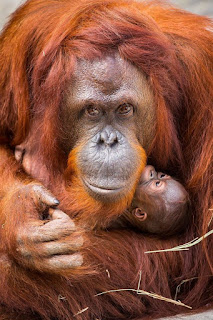Features
For this species, let's start by taking away a few human features:
- No groups. This species doesn't live or work in groups like humans do, no families or towns or tribes. They get together once a year to mate.
- No running or throwing. Their musculature just isn't right for it. That means they probably don't hunt, at least not by chasing or ambushing game.
- Big and tough. They have a thick hide and plenty of fur, like bears or mammoths, making them hard to attack at all.
- Scavenging. They eat dead animals, chasing off vultures and coyotes to do so.
- Gathering tasty vegetation to eat. They pick fruits, nuts, and the more nutritious leaves.
- Trapping. They make traps to catch wild animals.
- Burying food for later. They dig to make pit traps, so they might dig storage pits as well, storing food for the winter.
Appearance
So what do they look like? Big, tough, and furry. Teeth for ripping meat and chewing leaves. Hands that can dig pits and pull apart carcasses. Sounds like some kind of great ape to me.
These creatures are massive, weighing at least twice as much as a human. Like gorillas, they usually walk on all fours, but can stand upright to reach high branches.
Behavior
They live as individuals, roaming in a circuit across a wide territory, checking their traps, eating carcasses, and picking fruit. Less perishable food they bury for the winter.
To keep track of everything, these creatures have an excellent memory. Speed of thought isn't needed, but given time, they can recall nearly any detail. They're ponderers and dreamers, deep thinkers.
Their annual meetings are the most crucial event of the year. They gather to mate, but also to trade, gossip, and discuss plans for the next year.
I've been calling these creatures giants, though it's not a perfect fit. They're large and strong, but not much like the giants people usually think of.
An invented name would avoid preconceptions, but it wouldn't suggest anything if you don't already know it. Meeting a dumaka or a sosketi starts with nearly nothing—spotting a giant walking along the ridge, you have a picture to start with.
What would you call these creatures?



Wizarding name: Rhodopithicus Maxipod (the red ape with big feet) for obvious reasons.
ReplyDeleteCommon name: Sasquatch, bigfoot, wosemann, Wood-Ape
What would I call them? Maybe yetis or ape-men, mammoth-folk (heck make them real elephants with trunks to make up four the quasi-quadrapedness). They could also be some kind of hairy troll or ogre; those are expected to be a lot less human. Something along those lines. Play up the furriness and play down the humanity.
ReplyDeleteI think that you should play to the mysteriousness of the setting and uniqueness of the race by choosing an original name. Alternatively, play up the frontier america feel by drawing from the mythology of native americans like so https://en.m.wikipedia.org/wiki/Choctaw_mythology
ReplyDeleteYou're probably right. I keep wanting to have it both ways, with an understandable English name and a fictional/original name, but that might not be an option.
DeleteThey remind me of the elcor from the Mass Effect series.
ReplyDeleteI have thought of this post many times over the years since I first read it, and it has become the vision of giants that feels right to me.
ReplyDelete